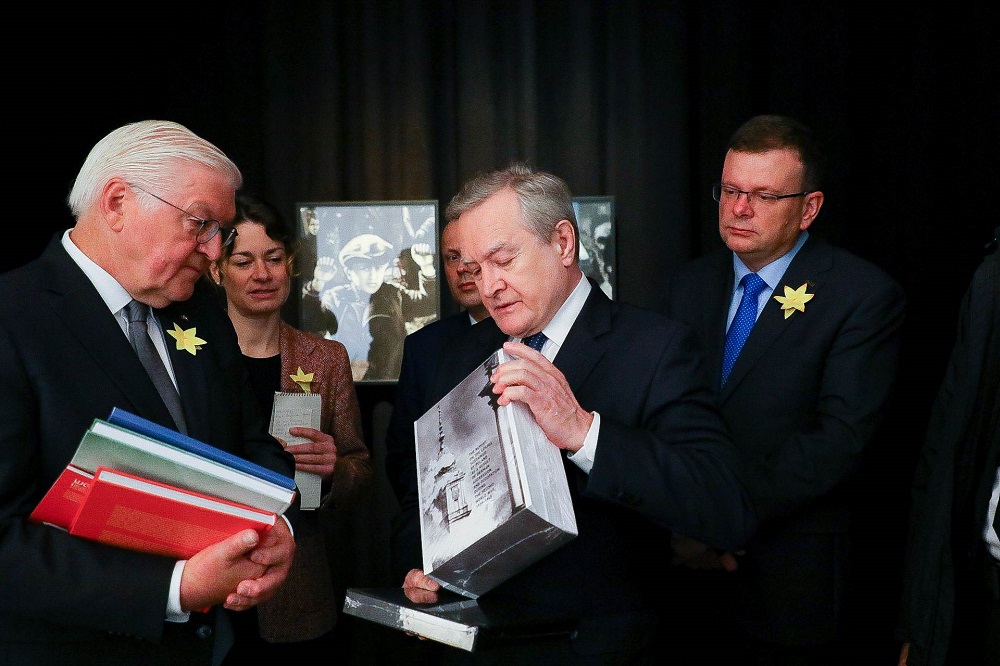
Deputy Prime Minister, Minister of Culture and National Heritage Piotr Gliński presented the German President Frank-Walter Steinmeier with the “Report on losses suffered by Poland as a result of German aggression and occupation during World War II 1939-1945” and a publication devoted to Polish war losses in culture.
“I am giving the president a full version of the report on Polish losses as a result of German aggression and occupation during WWII in English. This is very important for us for many reasons. We hope to start a dialogue with Germany on this subject” – said Deputy Prime Minister Gliński, addressing to President Steinmeier.
“I am also handing over to the president a publication devoted to cultural losses. It describes lost objects that have not been found. We hope to start a dialogue for the good of Europe, our future and friendship between our nations” – he added.
German President Frank-Walter Steinmeier paid a visit to Poland, where – apart from Deputy Prime Minister Piotr Gliński – he met, among others, with President Andrzej Duda
German institutions participated in the looting of Polish cultural goods
During World War II, until 1945, the Germans carried out organized theft of works of art in the countries they occupied. Importantly, these robberies were often accompanied by deliberate destruction in the name of the imposed ideology, which makes “plunder” a broader concept than “theft”.
As the researchers from the Institute of National Remembrance emphasize, it was characterized by a high degree of organization and preparations for its implementation had been made before the outbreak of the war. Paradoxically, Edward Chwalewik’s study from 1926 and 1927 turned out to be helpful in this respect, in which he described almost all Polish manor houses in terms of the works of art and artistic objects found in them. Although his descriptions were superficial, they turned out to be sufficient for the occupier, who, according to them, carried out subsequent occupations in individual estates. The Germans bought this publication en masse in Polish bookstores, and even had it translated into German” – historians remind us.
German institutions played a special role in looting, in particular the scientific and research community “Heritage of the Ancestors” (Forschungs- und Lehrgemeinschaft “Das Ahnenerbe”) operating under the direct leadership of Heinrich Himmler. “One of its tasks was to prepare lists of basic cultural institutions, especially those that had prehistoric collections. The list of monuments was formulated on September 10, 1939, and eight days later a list of museums, palaces, archives and other cultural institutions in Poland along with Peter Paulsen, a professor of prehistory at the University of Berlin, who had visited Polish museums several times before the war, was entrusted with the implementation of the plan to “secure” these properties. In particular, Jan Matejko’s paintings Prussian Homage and Battle of Grunwald were included in the lists. For its finding and handing over the Gestapo promised a reward of 10 million marks” – we read on the website of Polish Institute of National Rememberance.
In October 1939, the post of special commissioner for the protection of works of art was taken over by Dr. Kajetan Mühlmann, who testified before the International Military Tribunal: “It was the official policy of Governor General Hans Frank to secure all major works of art belonging to Polish public institutions, private collections and the Church. I confirm that the said works were actually confiscated, and I am aware that in the event of a German victory, they would not remain in Poland, but would be used to supplement German art collections”.
The scale of losses of Polish cultural goods in the years 1939-1945 is unimaginable
As emphasized by researchers of the losses suffered by Poland in the area of cultural property during World War II, the scale of these losses is practically impossible to estimate precisely, only approximate estimates can be made. The German occupier took from Poland about 2.8 thousand images of European painting, approx. 11 thousand paintings by Polish painters, approx. 1.4 thousand sculptures, about 15 million books, about 5,000 church bells. 25 museums, 35 theaters, 665 cinemas, 323 folk houses were destroyed.
After World War II, the cultural goods looted by the Nazis were taken over by West Germany. Amazingly, no German government has returned them to the victims. Only those works of art that the Allies managed to recover were returned. In 1966, the Bundestag decided that the remaining works of art would go to German museums, government residences, including the chancellor’s office and the seat of the president, and to German embassies. At that time, then Treasury Minister Werner Dollinger (CSU) publicly announced that the restitution process had finally been completed. And although in official rhetoric Germany has distanced itself from the legacy of the Third Reich, according to German media, the central German authorities currently have in stock about 20,000 paintings, valuable books, coins and furniture from “unexplained sources”.
Anna Wiejak
